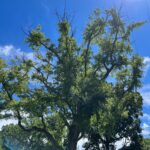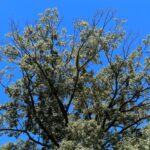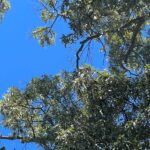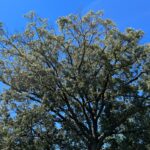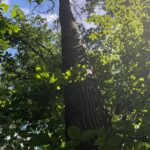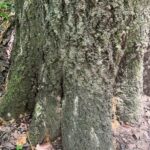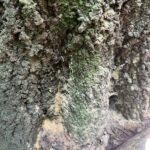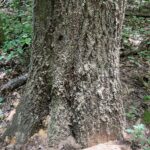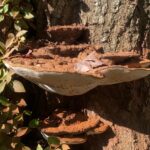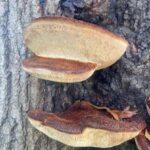Does my tree need to be removed?
A dead tree is pretty obvious to identify for the most part. No leaves, cracking bark, holes, etc. However, not all trees that people think are dead, are actually dead. A tree could be ‘in decline‘. So how do you know for certain if a tree needs to come down? You can call a certified arborist to come out and take a look. An arborist should be able to provide a professional opinion as to whether a tree can be saved, or not. Below, are some examples of potential tree issues that you can keep an eye out for:
Tree canopy tip dieback
Take a look at the following photos. You can easily see the tip dieback where the tips of the limbs are dying back to the live growth. Tip dieback is something to keep a close eye on. Hopefully, these Oaks will be Ok since they still have a good live crown ratio (percentage of live growth to dead limbs). Both tree trunks look good and have no apparent issues, fungi or insects present.
Tree borer activity, insect invasion
Take a look at the following photos. You can easily see that the leaves are completely gone in the summer months. Notice the borer holes and frass around the trunk. Observe the insect frass and holes where the wood is chewed out. It is definitely time for tree removal. Once borers have invaded a tree, a majority of the time it is too late to save the tree. This tree is dead and needs to be removed.
Tree fungal issues
There are many different types of fungi that trees can develop. Hypoxylon Canker in Oaks is a very common one. When an Oak has this fungus, it can die very quickly. Read our other article entitle, evaluating Oak trees. Fungi grows on decayed wood, see below for some examples:
Why are leaves turning brown and curling up in August?
If you see the leaves turning brown and defoliating early, you may need to water. Recently, we evaluated a customer’s Oak tree. The Oak tree had brown leaves that were very dry, and curled over around the edges. Many of the brown leaves had already fallen off onto the ground. The tree is located on a sloped ground, so water runoff is another factor. Our professional recommendation was to water the tree in the evenings for 30-45 minutes for a couple of weeks. After that, we received a call from our customer saying that the leaves were green again and the tree canopy looked so much better.
Why do trees go into decline, and die?
Most of the time environmental factors such as drought can have disastrous affects for trees. Insects and fungi are often times secondary issues. It is usually when a tree is already in decline that insects and fungi take over. Often we find ourselves saying, “let’s let the tree get through the coming Winter season and see how it comes back in the Spring time.” Tall mature trees need hundreds of gallons of water each and everyday to survive. A drought can really harm a tree’s health. In general, it is impressive how resilient trees are to overcome such things.
How to keep my trees healthy?
The best thing to do for the most part is to leave a healthy tree alone! If you have mature trees in your yard, having a certified arborist evaluate your trees on an annual basis is recommended. Trees in the forest are in their most ideal habitat. Replicating the native forest habitat in the urban forest is a good objective to keep your trees healthy for the long run. Soil tests are a good idea. Especially if any trees are in decline. Mulching and keeping lawn mowers and other equipment away from surface roots is good to avoid root damage and soil compaction. Some tree species like Oaks should not have over saturated ground water, so drainage is another important consideration.
